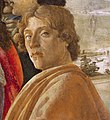
The Uffizi Gallery is a prominent art museum located adjacent to the Piazza della Signoria in the Historic Centre of Florence in the region of Tuscany, Italy. One of the most important Italian museums and the most visited, it is also one of the largest and best-known in the world and holds a collection of priceless works, particularly from the period of the Italian Renaissance.

Alessandro di Mariano di Vanni Filipepi, better known as Sandro Botticelli or simply Botticelli, was an Italian painter of the Early Renaissance. Botticelli's posthumous reputation suffered until the late 19th century, when he was rediscovered by the Pre-Raphaelites who stimulated a reappraisal of his work. Since then, his paintings have been seen to represent the linear grace of late Italian Gothic and some Early Renaissance painting, even though they date from the latter half of the Italian Renaissance period.
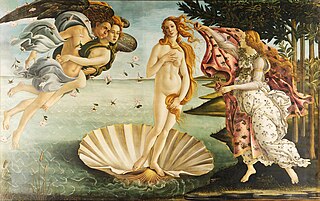
The Birth of Venus is a painting by the Italian artist Sandro Botticelli, probably executed in the mid-1480s. It depicts the goddess Venus arriving at the shore after her birth, when she had emerged from the sea fully-grown. The painting is in the Uffizi Gallery in Florence, Italy.

Filippino Lippi was an Italian Renaissance painter mostly working in Florence, Italy during the later years of the Early Renaissance and first few years of the High Renaissance. He also worked in Rome for a period from 1488, and later in the Milan area and Bologna.
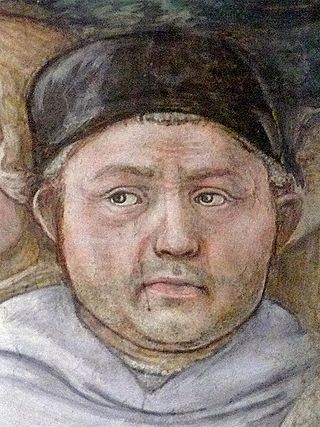
Filippo Lippi, also known as Lippo Lippi, was an Italian Renaissance painter of the Quattrocento and a Carmelite priest. He was an early Renaissance master of a painting workshop, who taught many painters. Sandro Botticelli and Francesco di Pesello were among his most distinguished pupils. His son, Filippino Lippi, also studied under him and assisted in some late works.
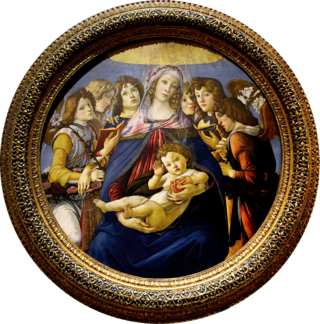
The Madonna of the Pomegranate is a tempera on panel painting created circa 1487 by the Italian Renaissance master Sandro Botticelli. It is now in the Uffizi in Florence. Sandro Botticelli was a leading Renaissance artist from Florence, Italy. The Madonna (art) uses the circular format, better known as a tondo, which focuses the attention on the main characters, the Virgin Mary and baby Jesus, who are surrounded symmetrically by angels on each side. Botticelli's use of tempera grassa give the characters a real look, better known as a "naturalistic" style, which is common during the Renaissance. The Virgin Mary is holding baby Jesus gently in her arms while holding a pomegranate in her left hand.
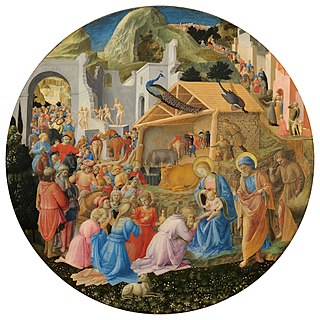
A tondo is a Renaissance term for a circular work of art, either a painting or a sculpture. The word derives from the Italian rotondo, "round". The term is usually not used in English for small round paintings, but only those over about 60 cm in diameter, thus excluding many round portrait miniatures – for sculpture the threshold is rather lower.

Madonna in Glory with Seraphim is a tempera painting on panel by the Italian Renaissance painter Sandro Botticelli, executed c. 1469–1470. It is housed in Galleria degli Uffizi.

Florentine painting or the Florentine school refers to artists in, from, or influenced by the naturalistic style developed in Florence in the 14th century, largely through the efforts of Giotto di Bondone, and in the 15th century the leading school of Western painting. Some of the best known painters of the earlier Florentine School are Fra Angelico, Botticelli, Filippo Lippi, the Ghirlandaio family, Masolino, and Masaccio.
The decade of the 1460s in art involved some significant events.
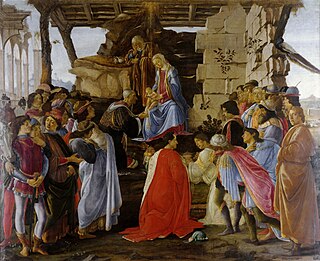
The Adoration of the Magi is a painting by the Italian Renaissance master Sandro Botticelli. Botticelli painted this piece for the altar in Gaspare di Zanobi del Lama's chapel in Santa Maria Novella around 1475. This painting depicts the Biblical story of the Three Magi following a star to find the newborn Jesus. The image of the altarpiece centers on the Virgin Mary and the newborn Jesus, with Saint Joseph behind them. Before them are the three kings who are described in the New Testament story of the Adoration of the Magi. The three kings worship the Christ Child and present him with gifts of gold, frankincense and myrrh. In addition, the Holy Family is surrounded by a group of people who came to see the child who was said to be the son of God.

The Madonna and Child with Six Saints, also known as Sant'Ambrogio Altarpiece, is a painting by the Italian Renaissance master Sandro Botticelli, finished around 1470. It is housed in the Galleria degli Uffizi, in Florence.
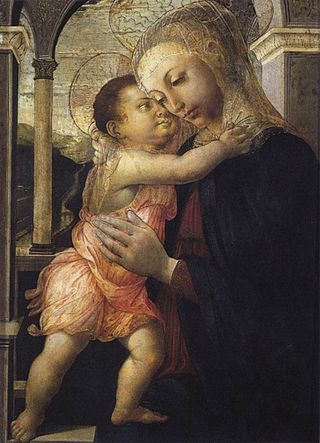
The Madonna della Loggia is a painting attributed to the Italian Renaissance artist Sandro Botticelli, dating to c. 1467. A tempera on panel work, it is located in the loggia of the Uffizi, Florence, Italy.

The Virgin and Child with the Infant Saint John the Baptist is a tempera painting on wood executed by the Italian Renaissance master Sandro Botticelli and his studio. The tondo, painted in Florence between the years of 1490 and 1500, addresses a central theme of the Italian Renaissance art: the divine motherhood. The work is now in the São Paulo Museum of Art.
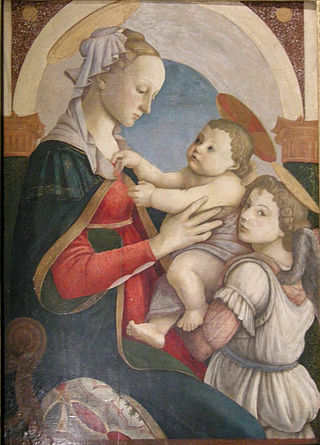
The Madonna and Child with an Angel is a painting executed c. 1465–1467 by the Italian Renaissance painter Sandro Botticelli. It is housed in Spedale degli Innocenti of Florence.

Primavera is a large panel painting in tempera paint by the Italian Renaissance painter Sandro Botticelli made in the late 1470s or early 1480s. It has been described as "one of the most written about, and most controversial paintings in the world", and also "one of the most popular paintings in Western art".

Madonna with Child is a painting by the Italian Renaissance artist Filippo Lippi. The date in which it was executed is unknown, but most art historians agree that it was painted during the last part of Lippi's career, between 1450 and 1465. It is one of the few works by Lippi which was not executed with the help of his workshop and was an influential model for later depictions of the Madonna and Child, including those by Sandro Botticelli. The painting is housed in the Uffizi Gallery, Florence, Italy, and is therefore commonly called “The Uffizi Madonna” among art historians.
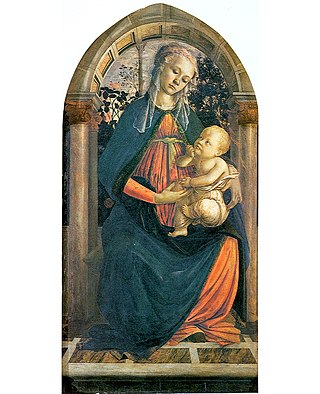
The Madonna of the Rose Garden is a tempera painting on panel by the Italian Renaissance painter from Florence, Sandro Botticelli between 1469 and 1470. It is one of his earliest paintings and is now in the Uffizi Gallery in Florence, Italy.

Virgin and Child with an Angel also known as Our Lady of the Eucharist is a painting in tempera on wood panel by the Italian Renaissance master Sandro Botticelli, executed in c. 1470. It is now held by the Isabella Stewart Gardner Museum in Boston, Massachusetts, having been acquired from Prince Chigi in 1899. The painting measures 85.2 × 65 centimetres (33.5 × 25.6 in) and is one of a series of paintings of the Madonna produced by Botticelli between 1465 and 1470. It shows influences from Filippo Lippi's Virgin and Child with Two Angels of c. 1465 in the Uffizi.

Lucrezia Buti was an Italian nun who later became the lover of the painter Fra Filippo Lippi and the mother of his children. She is believed to be the model for several Madonnas portrayed in Lippi's paintings.





















